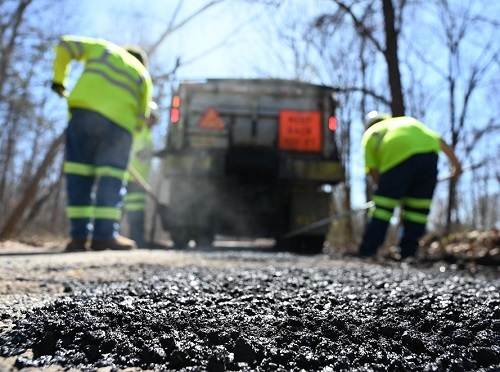The Federal Highway Administration has officially launched its Low Carbon Transportation Materials Program, which aims to lower air pollution – specifically greenhouse gas or GHG emissions – via “reimbursement and incentive funding” for low carbon construction materials and products used in transportation infrastructure projects.
[Above photo by WVDOT]
Established by the Inflation Reduction Act of 2022, the FHWA’s low carbon program will make $2 billion available to state departments of transportation, Native American tribes, Metropolitan Planning Organizations or MPOs, and transportation other agencies to buy materials that create less pollution – including steel, concrete, and asphalt.
In a statement, the FHWA explained that it will use a “hybrid approach” to implement the program:
- First, FHWA is making $1.2 billion available to states, the District of Columbia, and Puerto Rico through a Request for Applications or RFA to fund activities and projects that reduce pollution, including carbon emissions, through the use of low-embodied carbon materials and products. The agency said this approach allows it to quickly provide reimbursement or incentive funds to states to begin eligible activities and incorporate low-embodied carbon materials on construction projects now.
- Second, later in 2024, FHWA said it will make $800 million available for “non-state” applicants, including cities, Native American tribes, MPOs, and other transportation agencies through a notice of funding opportunity or NOFO. That NOFO will encourage applicants to partner with states where appropriate and will include offers of technical assistance for applicants, FHWA noted.
In addition to funding the use of cleaner construction materials that reduce pollution and carbon emissions for transportation projects, FHWA said its new low carbon program will provide resources for agencies to implement processes and coordinate with industry to quantify the emissions of construction materials.
That information will allow substantially lower carbon materials to be identified by comparing emissions to established thresholds, the agency pointed out, with funding also allowed for the development of specifications for low-embodied carbon materials that ensure adequate engineering performance for appropriate use on federal-aid projects.
Pete Buttigieg, secretary of the U.S. Department of Transportation, explained his agency’s perspective regarding the “climate benefits” from expanded use of low carbon materials during a panel discussion in January at the Transportation Research Board’s 2024 Annual Meeting in Washington, D.C.
“Our aim is to make infrastructure materials like pavement more effective, resilient, durable, and longer lasting than ever before,” Buttigieg explained at that session. “It’s about making the right kind of investments not just to rebuild our nation’s infrastructure but to redefine how it is built.”
He added that while only 60 years separated the first airborne flight at Kitty Hawk, N.C., and America putting a man on the moon, the transportation industry still relies on infrastructure materials in use during the Roman Empire.
“Our role, then, at USDOT, is to make sure we have a good understanding of the role of materials we use in transportation and how they are encoded into the decisions we make,” the secretary said. “There is a very low level of attention paid to materials research, but an even marginal change in quality could be massive if multiplied out among all the projects we work on.”

